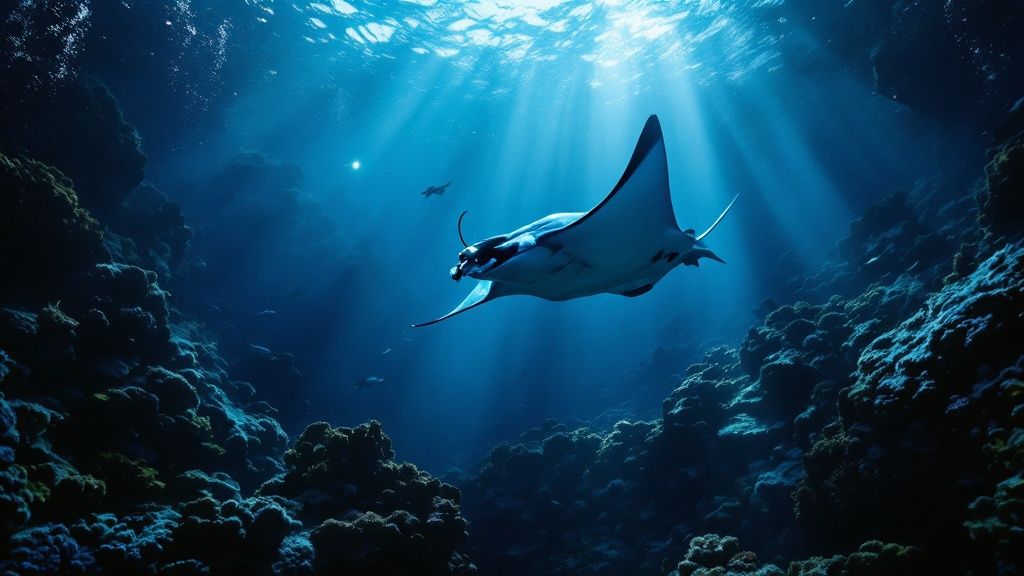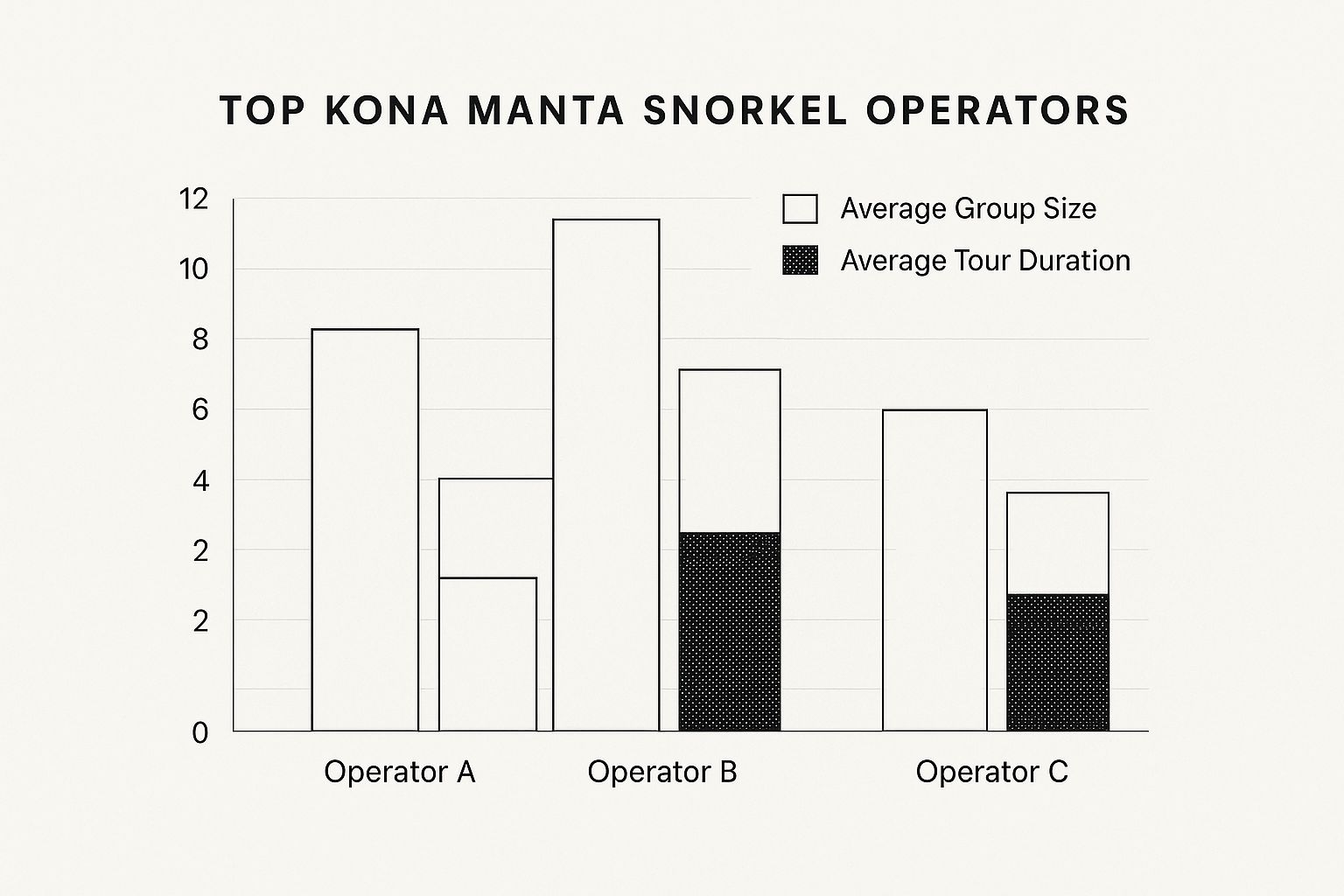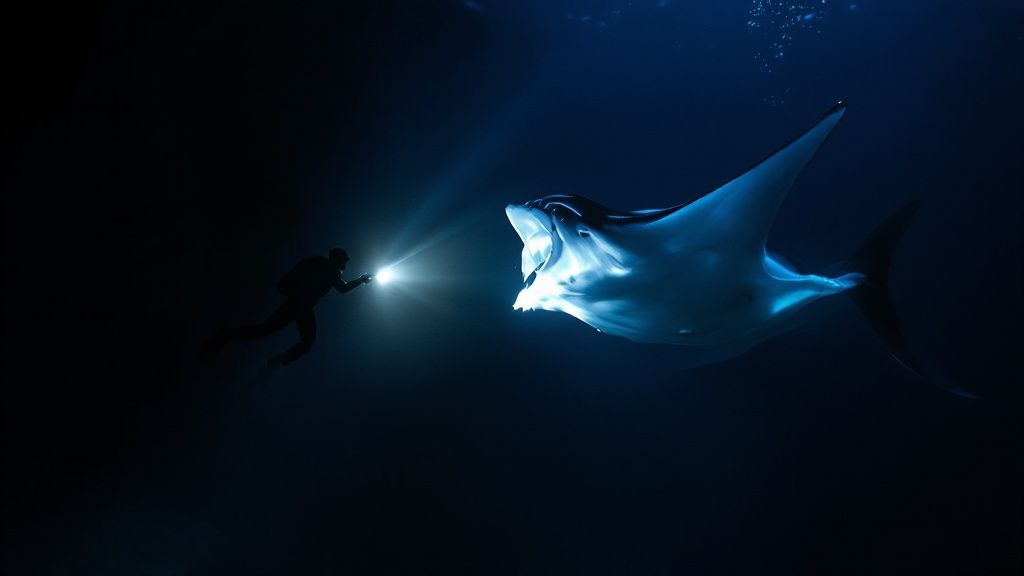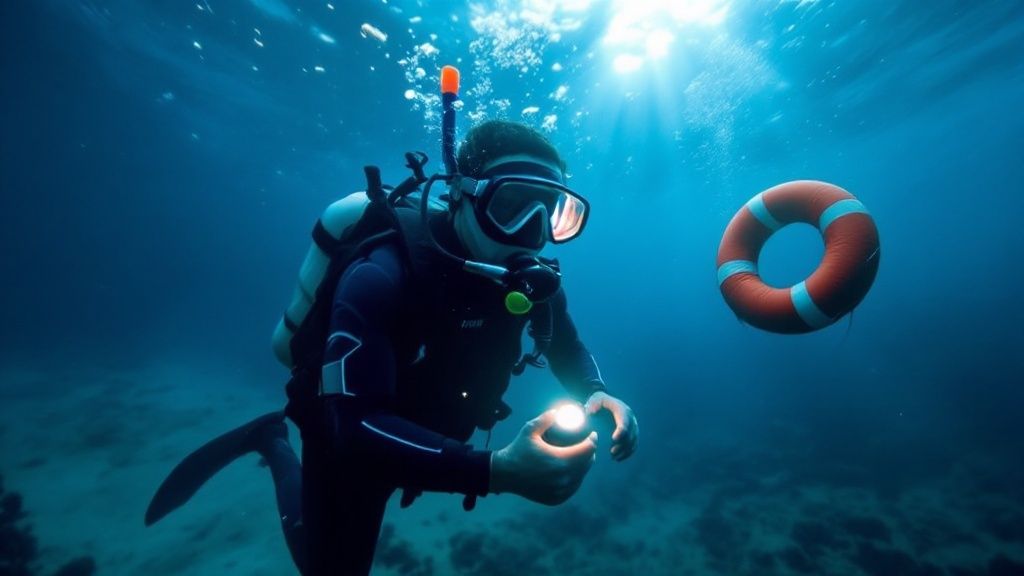Manta Ray Snorkel Kona: The Ultimate Hawaiian Adventure
- Byron
- May 18
- 12 min read
Why Manta Ray Snorkel Kona Transforms Every Hawaii Visit
Manta ray snorkel Kona is more than just a fun activity; it's a truly special experience. Imagine floating peacefully in the dark ocean as these gentle giants, some with 12-foot wingspans, perform a graceful underwater ballet just inches from your mask. This close encounter creates a deep connection with the ocean, leaving a lasting impression. This is what differentiates a Kona manta ray experience from other Hawaiian adventures.
The Kona Manta Ray Advantage
Kona's unique environment creates a haven for manta rays. Nutrient-rich currents sustain plankton blooms, the manta ray's main food source. This reliable food supply makes Kona a great place to see these magnificent creatures. Locations like 'Manta Village' and 'Manta Heaven' use special lights to attract plankton, ensuring amazing visibility during night dives.
This abundance of plankton and Kona's clear, warm waters practically guarantee an encounter. In fact, manta ray snorkeling in Kona attracts roughly 80,000 participants annually, with sighting success rates typically between 80-90% year-round. This remarkable consistency makes Kona a top destination for manta ray encounters. Find more detailed statistics here.
An Emotional Connection with Ocean Giants
Beyond the visual spectacle, a manta ray snorkel Kona offers a profound emotional connection. These gentle giants are known for their curiosity and often swim near snorkelers, building a sense of shared wonder. Witnessing their graceful movements and feeding patterns inspires awe and appreciation for these intelligent creatures. It's a shared experience that feels deeply personal.
From Obscure Adventure to Signature Experience
Manta ray encounters have become a must-do Hawaiian experience. Discover the magic for yourself with this guide: Manta Ray Snorkel Kona Hawaii: The Ultimate Experience Guide. This growing popularity highlights the increasing recognition of these encounters.
For example, marine conservation experts now recognize the value of these interactions for both visitors and the manta ray population. This understanding emphasizes the importance of responsible tourism and the role we play in protecting these animals and their habitat.

This unique blend of natural wonder, emotional connection, and responsible tourism makes the manta ray snorkel Kona experience truly special, adding an unforgettable element to any Hawaii trip.
Perfect Timing: When and Where to Experience Manta Magic
Planning a manta ray snorkel Kona adventure involves understanding manta ray behavior and the local environment. This knowledge maximizes your chances of a magical encounter.
Seasonal Variations and Manta Ray Behavior
Seasonal changes influence visibility, water conditions, and manta ray behavior. Summer offers calmer waters and increased plankton blooms, leading to more frequent manta ray activity. You might be interested in: Our ultimate guide on the best time to see manta rays in Kona. During peak season, you might see multiple mantas feeding simultaneously. The off-season can provide a more intimate experience with smaller groups, though sightings might be less frequent.
Manta Village vs. Manta Heaven
Choosing the right location enhances your manta ray snorkel Kona experience. Manta Village, near Keauhou Bay, offers a dramatic backdrop and consistently high sighting rates. Getting there from Keauhou Bay minimizes travel time after your snorkel. Manta Heaven, off the Kona International Airport, is known for larger manta ray aggregations. While the success rate might be slightly lower than Manta Village, the number of mantas can be spectacular.
Moon Phases and Plankton Concentration
The moon plays a crucial role in your manta ray viewing experience. Plankton, the manta ray's primary food source, is more visible in darker conditions. A new moon or crescent moon offers ideal viewing as reduced ambient light enhances the plankton's bioluminescence, attracting more manta rays. Even during brighter moon phases, specialized tour operator lights create localized plankton concentrations, ensuring consistent manta ray activity.
Operator Insights and Water Entry Techniques
Experienced manta ray snorkel Kona guides use specific water entry techniques to minimize disturbance and optimize snorkeler positioning. They instruct participants to enter calmly and hold onto a floating platform with lights. These lights attract plankton, drawing the manta rays closer. This provides a stable viewing platform and minimizes disruption to manta ray feeding behaviors.
To understand the differences between Kona manta ray snorkel operators, see the comparison table below. It shows the average group size and tour duration for three top operators.
To help you choose the perfect snorkel spot, we've compiled the following table:
Location | Success Rate | Best Time | Water Conditions | Special Features |
|---|---|---|---|---|
Manta Village | High | Year-round | Typically Calm | Close to Keauhou Bay, dramatic backdrop |
Manta Heaven | Moderate | Year-round | Can be variable | Larger manta ray aggregations |
After reviewing the table, it's clear that each location offers a unique experience. Manta Village boasts a higher success rate, while Manta Heaven offers the potential for larger groups of manta rays.

As shown, Operator C offers a more intimate experience with smaller groups and shorter tours, while Operator B caters to larger groups with longer tours. Operator A balances group size and tour length. Choosing the right operator depends on your preferences. By considering these factors, you can create an unforgettable manta ray snorkel Kona adventure.
The Manta Ray Snorkel Kona Experience Unveiled
Imagine the Kona sunset: vibrant oranges and purples painting the sky as you approach the manta ray viewing area by boat. The anticipation is palpable. This is where your Kona manta ray snorkel adventure begins.
From Boat to Breathtaking Encounter
Experienced guides orchestrate the transition from boat to water, explaining the best entry techniques. This minimizes disturbance to the manta rays and maximizes your viewing experience. You'll likely enter the water calmly and hold onto a specialized, lighted floating platform. These lights attract the stars of the show.
The Plankton Soup and the Gentle Giants
The specialized lighting creates a "plankton soup," a concentrated cloud of plankton. This attracts the manta rays, which are filter feeders. They strain these tiny organisms from the water. As the mantas approach, you'll witness their graceful movements, their enormous wingspans creating mesmerizing underwater ballets just inches from your mask. Check out our guide on the Kona manta ray snorkel experience.

Decoding Manta Communication and Personality
Observe these gentle giants, and you'll notice distinct personalities and communication styles. Some mantas are curious and approach snorkelers closely, while others are more reserved. Their swimming patterns reveal insights into their feeding strategies. Barrel rolls, graceful loops performed while filtering plankton, are a common feeding behavior.
Addressing Concerns: Water Temperature and Comfort
Many have questions about water temperature and comfort during a night snorkel. Kona's water is generally warm, but a wetsuit is typically provided for comfort. Guides address any concerns about night swimming and manta ray proximity, preparing you for this extraordinary encounter.
Manta Ray Monitoring and Conservation Efforts
Much of the long-term monitoring of Kona's manta rays has been facilitated by professional divers, underwater explorers, and cameramen. Organizations like Ocean Wings Hawaii, Inc. have contributed significantly to data collection, often based on personal observations and video footage from night dives. This monitoring helps scientists understand manta ray behavior and population dynamics, ensuring the continued success of these encounters. The data collected over the years has been crucial for maintaining the high success rate of manta ray sightings. Discover more insights about manta ray monitoring here. This research and responsible tourism help preserve this unique marine ecosystem. You might also want to read this article about manta ray snorkel Kona adventures.
Selecting Your Perfect Manta Ray Snorkel Kona Adventure
Picking the right manta ray snorkel tour in Kona can truly make or break your experience. This guide will walk you through the options, helping you find the perfect fit for your needs and budget. Think about things like vessel type, group size, and guide expertise to really maximize your manta magic.
Group Size and Intimacy: Finding Your Sweet Spot
Smaller groups offer a more intimate and personalized experience. With fewer people in the water, there’s less splashing and commotion, allowing for better viewing opportunities. You’ll also have more chances to connect with your guides and ask questions. Larger groups, while sometimes more budget-friendly, can feel crowded, potentially impacting your interaction with the mantas.
Guide Expertise: Your Underwater Interpreter
Guides with a strong marine biology background can add another layer of depth to your tour. Look for operators who emphasize education. They can provide fascinating insights into manta ray behavior, biology, and the Kona ecosystem. This knowledge enriches your appreciation of these gentle giants. Knowledgeable guides also understand manta ray behavior and know the best, most respectful ways to get you close to the action.
Equipment and Comfort: Gearing Up for the Night
Having the right equipment is crucial, especially for a night snorkel. Some operators provide high-quality wetsuits, masks, and snorkels designed for optimal comfort and visibility in low-light conditions. Be sure to ask about the provided gear and consider what you’ll need to feel comfortable. Some tours even offer flotation devices for those who want extra support.
Questions to Ask and Red Flags to Avoid
Before booking, ask specific questions to understand the operator's commitment to guest experience and marine conservation. Here are a few key questions:
What is the maximum group size?
What is the guide's experience level and marine biology background?
What type of vessel is used?
What safety protocols are in place?
Is the operator committed to sustainable practices?
Be cautious of operators who seem to prioritize large numbers of guests over quality. Red flags might include excessively large group sizes, a lack of focus on conservation, or vague answers to your questions.
Comparing Your Manta Ray Snorkel Kona Options
To help you decide, the table below summarizes the key aspects to consider when choosing your manta ray snorkel Kona adventure.
To simplify your decision-making process, the table below summarizes key aspects to consider when selecting your manta ray snorkel Kona experience.
Tour Type | Group Size | Price Range | Equipment Provided | Experience Level | Special Features |
|---|---|---|---|---|---|
Budget Group Tour | 15-20 | $80-$120 | Basic | Beginner | Snacks & Drinks |
Standard Group Tour | 10-15 | $120-$180 | Upgraded | Beginner | Photographer |
Small Group Tour | 6-10 | $180-$250 | Premium | Intermediate | Hydrophones |
Private Charter | 2-6 | $300+ | Customizable | All Levels | Personalized Itinerary |
This table gives you a quick overview of the different tour types available, making it easier to compare group sizes, price ranges, and special features.
Choosing the right tour can significantly elevate your manta ray encounter. Remember to prioritize smaller groups, experienced guides, and responsible tourism practices for the best manta ray snorkel Kona experience. A little research ensures a truly unforgettable adventure with these majestic creatures.
Preparing for Magic: Manta Ray Snorkel Kona Essentials
Transform your manta ray encounter from an average experience into something truly extraordinary with these preparation strategies. This advice goes beyond the usual packing lists, offering valuable insights from those intimately familiar with these waters.
Optimizing Your Gear for Manta Ray Encounters
Proper gear preparation is essential for a comfortable and rewarding manta ray snorkel Kona adventure. A 3mm wetsuit is often recommended, providing a good balance of warmth and flexibility in Kona's night waters. While the ocean temperature is generally pleasant, a wetsuit offers added comfort during an extended time in the water.
Mask preparation is also key. While commercial anti-fog solutions are available, a simple spit-shine can be surprisingly effective. Also, consider bringing a pool noodle for extra buoyancy, especially if you're not a confident swimmer. This can help you relax and focus on the mesmerizing manta rays.

For underwater photographers, capturing these magical moments requires specific preparation. Red-filtered lights help maintain natural colors in low-light conditions without disturbing the manta rays. Adjusting your camera settings beforehand, such as using a higher ISO and wider aperture, is crucial for capturing clear images.
Mastering Breathing and Managing Currents
Managing your breath and body in the water is vital for a truly immersive experience. Practicing calm breathing techniques before your manta ray snorkel Kona tour can help you stay relaxed, especially when experiencing the excitement of a close manta ray encounter.
Understanding how to handle unexpected currents is also important. Kona's waters are generally calm, but conditions can change. Listen to your guide’s instructions and stay close to the group. If you feel overwhelmed, communicate with your guide; they are trained to assist and ensure your safety.
Special Considerations for Anxious Swimmers and Children
If you're an anxious swimmer or bringing children on the tour, a little extra preparation can make a world of difference. Visualization techniques can be very helpful. Imagine yourself calmly floating in the water, surrounded by graceful manta rays. This mental preparation can ease anxiety and build excitement. You might find this helpful: Our guide on swimming with manta rays in Hawaii.
For children, practicing with snorkel gear in a pool before the tour can build confidence. Explain what to expect, emphasizing the gentle nature of manta rays. Ensure they understand the importance of staying close to the guide and following instructions.
The Power of Preparation: Making Memories That Last
From gear optimization and breathing techniques to addressing anxiety and preparing children, pre-tour preparation has a significant impact on the quality of your manta ray memories. By following these simple yet powerful strategies, you can elevate your manta ray snorkel Kona experience from good to unforgettable. These preparations allow you to fully appreciate the magic of these gentle giants and create memories to cherish for a lifetime.
Swimming With Giants: Ethical Manta Ray Interactions
The magic of a manta ray snorkel Kona experience isn't just a quick peek; it's about building a deep respect for these gentle giants and the fragile ecosystem they call home. Responsible tourism is now vital for manta ray protection, ensuring these magnificent creatures thrive for generations to come.
Understanding Hawaii's Manta Ray Protection Laws
Hawaii has made great strides to protect its manta ray population. State law forbids harming, harassing, or capturing manta rays, recognizing their importance to the marine ecosystem and the tourism industry. This legislation provides a sanctuary for these gentle giants, allowing them to flourish in their natural environment. This means interactions must be non-invasive and respectful, letting the manta rays continue their natural behaviors undisturbed.
Manta Ray Identification and Tracking: A Collaborative Effort
Researchers and tour operators collaborate to identify and track individual manta rays. Each manta has unique spot patterns on its underside, similar to a human fingerprint. By photographing these patterns, researchers can monitor individual manta movements, population size, and overall health. This teamwork provides vital data for conservation, ensuring the long-term health of Kona's manta ray population.
Respectful Interaction Guidelines: Minimizing Our Impact
Specific interaction guidelines are in place to minimize human impact on manta rays and their feeding. These guidelines generally include:
Maintaining a safe distance: Avoid touching or trying to ride the manta rays. This can disrupt their natural behaviors and possibly harm their delicate skin.
Controlled movements: Avoid sudden movements or splashing, which can frighten the mantas and interrupt their feeding.
Respecting their space: Allow the manta rays to approach you, rather than chasing them.
No flash photography: This can hurt and scare away the mantas.
These practices ensure a positive experience for both visitors and the manta rays. Learn more in our article about the epic manta ray night snorkel on the Big Island.
Sustainable Practices: Championing Responsible Tourism
Many Kona tour operators prioritize sustainable practices, showing their commitment to manta ray conservation. These practices often include:
Using red-filtered lights: These minimize disruption to the manta rays’ natural environment and attract plankton without bothering other marine life.
Limiting group sizes: Smaller groups minimize disturbance to the manta rays and their feeding patterns.
Educating visitors: Knowledgeable guides teach visitors about manta ray behavior, biology, and the importance of conservation.
Citizen Science: Enhancing Your Experience While Contributing to Conservation
Many manta ray snorkel Kona tours offer chances to participate in citizen science projects. You can contribute to ongoing research by sharing your photos and observations with researchers. This not only enriches your experience but also provides valuable data for manta ray conservation. By actively participating in these initiatives, you become part of a bigger effort to protect these amazing creatures.
The Ripple Effect: Your Choices Matter
Every choice you make as a visitor, from choosing a responsible tour operator to following interaction guidelines, impacts this unique marine ecosystem. By embracing ethical manta ray interactions, you become a steward of the ocean, ensuring these magical encounters continue for future generations. Your mindful actions contribute to the long-term health and vitality of Kona's manta ray population and the broader marine environment. This creates a sustainable future for manta rays and the incredible Kona manta ray snorkel experience.
Beyond One Night: Extending Your Manta Ray Connection
Your manta ray snorkel Kona adventure doesn't have to end when you climb back on the boat. You can transform a single encounter into a lasting connection with these magnificent creatures and the vibrant marine environment they call home.
Continuing the Kona Manta Ray Journey
Beyond the initial thrill of a manta ray snorkel Kona experience lies a deeper engagement with these gentle giants. Numerous opportunities exist to extend your connection, enrich your understanding, and contribute to their protection. Build upon the memories of your snorkel by delving further into the world of manta rays and marine conservation.
Complementary Marine Experiences: Explore other wonders of Hawaii's marine ecosystem. Consider whale watching tours, snorkeling or diving on vibrant coral reefs, or exploring fascinating tide pools. These experiences offer diverse perspectives on the intricate relationships within the ocean and the delicate balance that sustains life. Broaden your understanding of the environment that supports these gentle giants.
Manta Identification Programs: Many research organizations and tour operators offer manta ray identification programs. By submitting your photos and videos, you contribute valuable data, helping track individual manta movements and aiding vital research. Imagine the thrill of identifying the very manta you encountered during your snorkel – a tangible link to their world.
Supporting Research and Conservation: Several organizations provide opportunities to directly support manta ray research and conservation efforts. Consider adopting a manta or participating in a research dive experience. These options offer crucial financial support for ongoing studies and allow you to actively participate in protecting these incredible animals.
Capturing and Identifying Your Manta Memories
Preserving the magic of your manta ray snorkel Kona encounter is easy with a few simple techniques. These tips will help you capture stunning images and perhaps even identify the specific mantas you saw, strengthening your connection even further.
Specialized Photography Techniques: Capturing high-quality images during a night snorkel requires specific camera settings and lighting. Using red-filtered lights minimizes disturbance to the mantas while preserving natural colors in your photographs. Adjusting your camera's ISO and aperture settings beforehand optimizes your chances of clear, vibrant images in low-light conditions.
Identifying Specific Mantas: Each manta ray has unique markings on its underside, much like a fingerprint. By comparing your photos to online databases, you might identify the individuals you encountered. This adds a personal touch to your memories and deepens your connection to these unique creatures.
Turning Experience into Action: Transform your awe into meaningful action by supporting organizations dedicated to protecting manta rays and their habitat. When swimming with manta rays, minimize your impact on the environment. Learn about ways to prevent marine pollution. Even small actions like reducing plastic consumption or supporting sustainable tourism make a difference. For further information, check out our article about unforgettable Hawaii encounters.
By extending your connection beyond a single night, you not only deepen your appreciation for these gentle giants but also contribute to their future.
Ready to experience the magic of manta rays in Kona? Book your unforgettable adventure with [Manta Ray Night Snorkel Kona Hawaii Tours](https://www.mantaraynightsnorkelhawaii.com) today!
Comments